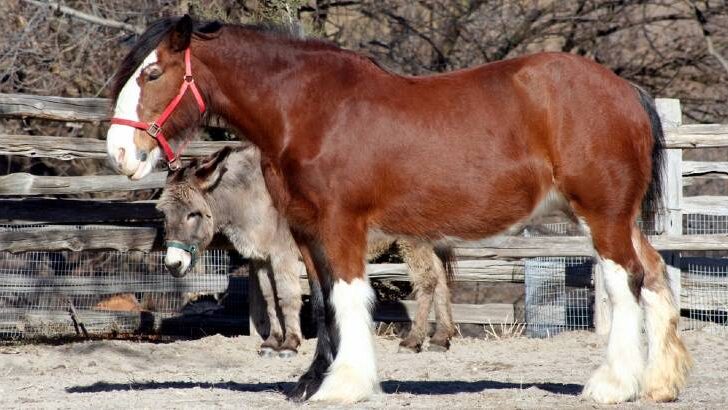Affiliate Disclaimer
As an Amazon Associate I earn from qualifying purchases. It helps me keep the website going. Thank you for your support.
Have you ever wondered which is stronger – horses or donkeys? It’s an interesting question because both species are used in situations that require a lot of strength and power. Donkeys in particular have been used as pack animals for nearly 7000 years and still are in many developing countries. But are donkeys stronger than horses?
As it turns out – on a weight-for-weight basis, donkeys are actually stronger than horses. Horses however are more powerful. What’s the difference? ‘Powerful’ applies more to motion, so a horse can pull more than a donkey of the same size and weight. ‘Strong’ refers more to physical abilities like weight bearing, and this is where donkeys come out in front. They can carry more than a horse or pony the same size and weight as themselves.
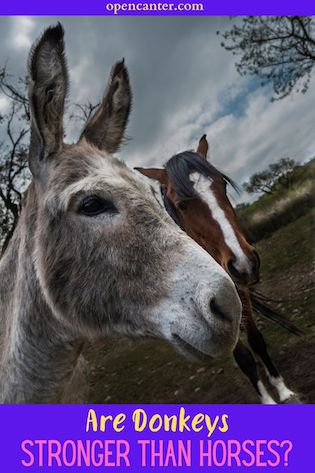
Donkeys Can Carry More Weight Than Horses
Horses and ponies can safely carry up to 20% of their body weight. Donkeys on the other hand can safely carry between 20 and 30% of their body weight, although they often carry a lot more than that! There are several very good anatomical reasons for this.
Skeletal Strength and Structure Make Donkeys Stronger Than Horses
Donkeys are a lot more compact and sturdy in build than horses and ponies. They have denser thicker (stronger) bones and larger joints, particularly in the legs and spine. Their legs for example are shorter and thicker than those of a horse or pony the same size.
Most donkeys also have 5 lumbar vertebrae compared to a horse’s normal 6 (source), which means they have a shorter, straighter back. The lumbar vertebrae in equids are located where the seat and back of your saddle sit i.e. between the ribs and the pelvis. Donkeys also have fewer caudal (tail) vertebrae.
These differences in bone density and strength, coupled with their more compact skeleton and shorter back, are a large part of the reason why donkeys can carry more weight than a horse or pony of the same height and weight.
Lower Centre Of Gravity Gives Donkeys Greater Weight Bearing Capacity
Having comparatively shorter legs than horses and ponies the same size means donkeys have a lower center of gravity.
The laws of physics tell us that anything with a lower center of gravity is more stable and better balanced than something with a higher center of gravity (think of a low-slung sports car vs a 4×4 with large off-road tires – which would you rather take a sharp bend in!).
In the case of donkeys, this higher degree of stability and balance allows them to safely carry more weight. This further contributes to making donkeys stronger than horses with respect to weight bearing.
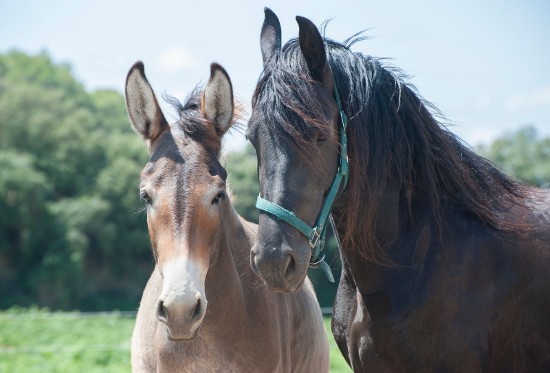
Donkeys Have Different Muscle Fibre Type Ratios To Horses
Muscles are made up of fibers, of which there are 3 types:
- Slow twitch (type 1)
- Fast twitch (type IIA)
- Fast twitch (type IIB or X)
Almost all muscles have all 3 types of fibers in varying ratios. This ratio can change though depending on workload, training, diet, etc. Fundamentally, however, the type of fiber that predominates in a muscle:
- Depends on what the muscle is required, or trained, to do, and
- Governs how that particular muscle performs i.e. whether it behaves as a slow twitch or fast twitch muscle.
A horse’s jaw muscles, for example, have a high % of type 1 fibers (because they need to spend hours chewing) whilst their hindquarter muscles have a high % of type IIB fibers.
Type 1 Muscle Fibers
Type 1 muscle fibers are ideally suited for endurance and strength activities. Here’s why…
- Type 1 muscle fibers use aerobic (oxidative) metabolism to produce cellular energy (ATP) i.e. they use oxygen to convert fats, proteins, and carbohydrates into ATP. This type of energy is ideal for sustaining prolonged, low-intensity activities (like weight lifting and endurance).
- Type 1 muscle fibers also have a lot of mitochondria (cellular ‘power stations’), which means they can produce more energy over longer periods without becoming fatigued. Individuals that have a lot of type 1 muscle fibers, like donkeys and weight lifters, can therefore carry out extended endurance activities without getting tired quickly.
Type IIB Muscle Fibres
Conversely, type 11B fast twitch muscle fibers like those found in the hindquarters of horse breeds like Thoroughbreds and Quarter Horses, are designed to produce short bursts of explosive power and speed.
These muscle fibers use anaerobic (glycolic) metabolism to produce cellular energy i.e. they are able to convert glucose into ATP very rapidly. However, although glucose metabolism produces energy much faster than oxygen-based metabolism, the type of energy produced is short-lived and better suited for fast, quick, energy-intensive activities like sprinting.
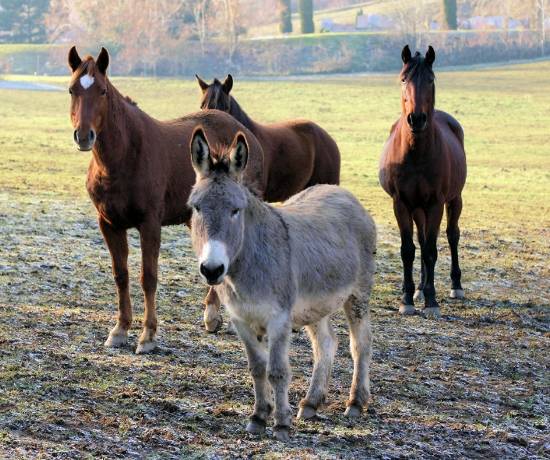
Donkeys Have More Endurance Muscle Fibres Than Horses
Like all equids, donkeys have all 3 types of muscle fibers. Where they differ slightly from horses though is that they tend to have a higher % of type 1 fibers in some of their muscles, notably, ones used for skeletal stabilization and weight bearing. This may contribute to making donkeys stronger than horses in some ways.
1) Longissimus dorsi
The Longissimus dorsi (the main stabilizing muscle along the spine) is one of these muscles. Studies have found that the average Longissimus dorsi muscle in donkeys has around 22% type 1 muscle fibers (source) compared to horses with an average of around 14% (source).
This, combined with their shorter back, may play a significant role in making a donkey’s back stronger and more capable of weight bearing, and for longer periods, than horses.
2) Psoas major
The Psoas major is another important stabilizing muscle. In equids, it runs from the lumbar vertebrae through the pelvis to the femur bone in the hind leg. Its primary role is controlling and stabilizing hip flexion, and it’s involved in the collection of the hindquarters, acceleration, jumping, and so on.
In horses, the Psoas major has around 30% type 1 muscle fibers, the rest being type 11A (~19%) and type IIB (~51%). The high % of type IIB fibers in this muscle help give horses the explosive hindquarter power they’re renowned for (and is a key part of their flight response to danger).
In donkeys however, over half (56%) of the muscle fibers in this muscle are type 1. (source) This means a donkey’s hindquarters are more suited to endurance activities, like weight-bearing, rather than explosive bursts of power and speed.
3) Biceps femoris
Interestingly, the Biceps femoris muscle that runs from the croup down the side of the rump to the middle of the tibia bone in the stifle area has a higher % of type 1 fibers (~17%) in horses than in donkeys (~9%). This muscle helps move and control the hip and stifle joints. It is involved in movements like rearing and forward motion… and kicking!
Donkeys are known for their explosively powerful kick, designed by evolution to fight off predators. It’s therefore interesting to speculate that this could be because they have such a high % (~91%) of type II fibers in their Biceps femoris!
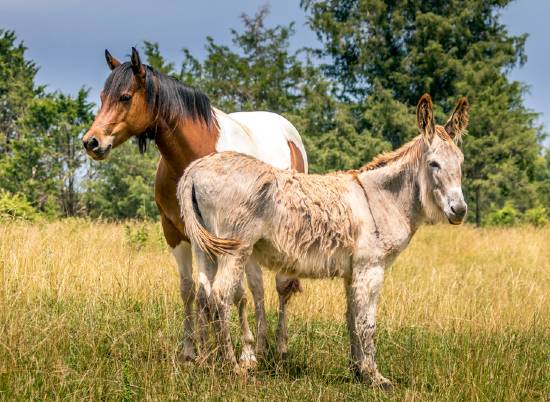
Less Muscle Mass May Make Donkeys Stronger Than Horses
Donkeys also have less muscle mass than horses and ponies the same size. Although you’d think this worked against making donkeys stronger than horses, having less muscle mass means they don’t need as much energy to move. That in turn means they require less food and water too.
A Tougher Metabolism May Make Donkeys Stronger Than Horses
In comparison to the relatively ‘cushy’ evolutionary history of horses and ponies, donkeys evolved in the tough arid desert environments of Africa. Therefore, although they’re often fed like horses, they do in fact have a slightly different but far more efficient, and tougher, metabolism.
Donkeys Have a More Effective Metabolism
Donkeys had to survive on what they could find to eat in their tough arid environment. That included whatever grass was available as well as shrubs, bark, and other edible vegetation.
Because most of this forage was low in nutrients, donkeys became remarkably efficient at absorbing whatever nutrients it did contain. For this reason, donkey manure makes poor compost compared to horse manure because it has very few nutrients left in it!
Donkeys Have a Slower Metabolism
They also have a slower metabolism than horses and ponies. This allows them to conserve their energy because they’re not burning through calories as fast as a horse or pony would. So – when it comes to long-distance trekking activities and carrying heavy loads, donkeys are more resilient courtesy of their more efficient metabolism.

Does This Make Donkeys Stronger Than Horses?
It doesn’t make them ‘stronger’ per se. However, it does make them tougher. Donkeys can work for longer, and travel further, without tiring or requiring food and water. This is not to say they should, but that they can! They can also survive on a lot less food than a horse or pony the same size.
Other characteristics that are often thought to contribute to making donkeys stronger than horses include:
- Tough hooves
- Slow and steady paces
- Ability to maintain their footing and balance on hilly, uneven terrain
Final Thoughts
While horses are more powerful and can pull more, donkeys come out in front in terms of weight-bearing ability. This is likely because of their more compact build, shorter backs, lower center of gravity, and denser bones.
Their higher proportion of low twitch ‘endurance’ fibers in certain muscles and robust metabolism also means donkeys can work longer and travel further on less food and water than horses. These attributes all help make donkeys stronger than horses and better at doing certain things.

